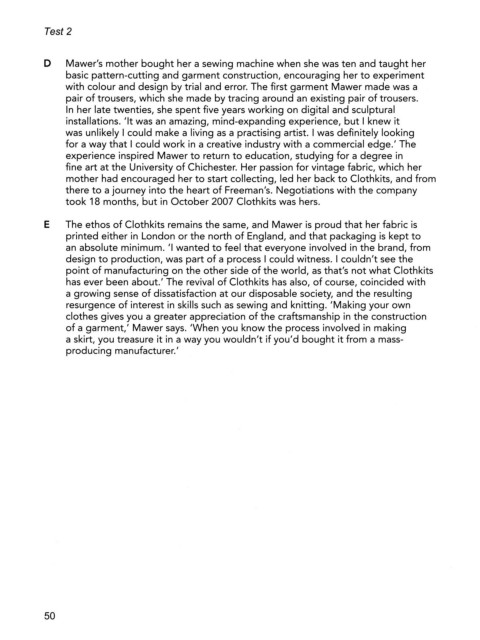Page 345 - Cam General 15-16-17-18-19
P. 345
Test 2
D Mawer’s mother bought her a sewing machine when she was ten and taught her
basic pattern-cutting and garment construction, encouraging her t。 experiment
with colour and design by trial and erro「. The first ga「ment Mawer made was a
pair of trousers, which she made by tracing around an existing pair of trousers.
In her late twenties, she spent five years wo「king on digital and sculptural
installations. ’It was an amazing, mind-expanding experience, but I knew it
was unlikely I could make a living as a practising artist. I was definitely looking
for a way that I could work in a creative industry with a commercial edge.’ The
experience inspired Mawer to return to education, studying for a degree in
fine art at the University of Chichester. Her passion for vintage fabric, which her
mother had encouraged her to start collecting, led her back t。 Cl。thkits, and from
there to a journey into the heart of Freeman’s. Negotiations with the company
took 18 months, but in October 2007 Clothkits was hers.
E The ethos of Clothkits remains the same, and Mawer is proud that her fab「ic is
printed either in London or the north of England, and that packaging is kept t。
an absolute minimum. ’l wanted to feel that everyone involved in the brand, from
design to production, was part of a process I could witness. I couldn’t see the
point of manufacturing on the other side of the world, as that’s not what Clothkits
has ever been about.’ The revival of Clothkits has also, of course, coincided with
a growing sense of dissatisfaction at our disposable society, and the resulting
resurgence of interest in skills such as sewing and knitting. ’Making your own
clothes gives you a greater appreciation of the craftsmanship in the construction
of a garment,’ Mawer says. ’When you know the process involved in making
a skirt, y。u treasure it in a way you wouldn’t if you'd bought it from a mass-
producing manufacturer.’
50

